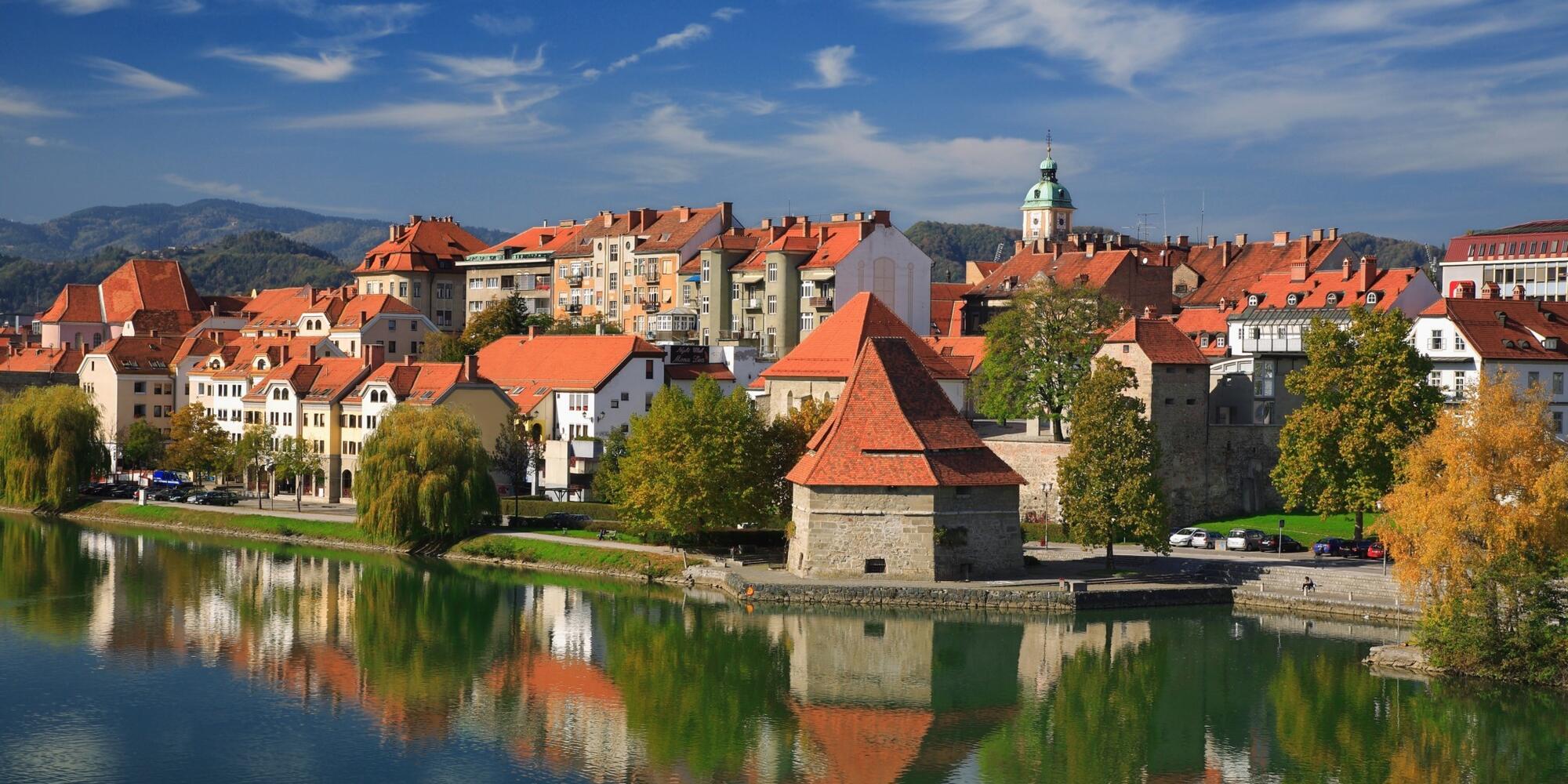
Maribor
Maribor is wonderfully nestled in the embrace of the green Pohorje mountains on one side and the picturesque wine-growing hills on the other. The city is located by the Drava River and in its centre grows the oldest, over 450 years old, vine in the world. Maribor is the European Capital of Culture 2012, Timber rafting city 2012, Silver Slovenia Green Destination, European City of Sport 2018, one of the TOP 10 tourist destinations in the world in the opinion of various media in the past few years, the centre of one of the fastest growing destinations in Slovenia, and the city of the oldest vine in the world, attracting many visitors from all over the world to the Old Vine House.
The richness of urban and rural nature offer numerous opportunities for relaxation, rambling, cycling, riding, adrenaline, skiing and other sporting ventures, as well as for cultural, ethnological, wine and culinary and wellness adventure!
Natural heritage
The Old Vine, World's Oldest Vine, and The Old Vine House
In the heart of the old city centre on Lent, the oldest vine in the world still grows in front of the Old Vine House. The confirmed age of this Žametovka or Modra Kavčina vine is over 400 years, which won it a place in the Guinness Book of Records as the oldest noble vine in the world still bearing grapes. The Old Vine is a symbol of the rich wine culture of Maribor, Styria, and all of Slovenia.
The House used to be a part of the city wall, and often witnessed furious fights between the defenders of the city, and invaders. In medieval times the House suffered from several fires, but the resilient Žametovka growing in front of it survived unscathed to the present day. It also made it through World War II bombing, which partially demolished the House.
In the Old Vine House, visitors can visit helpful tourist information centre, the wine shop and the room for wine tastings of premium wines from the Maribor wine sub region as well as a souvenir shop where they sell delicious Slovene chocolates.
Pohorje mountain
The green Pohorje is situated in the far end of the Alps. It neighbours the playful wine-growing hills of Slovenske gorice and is linked by the Drava River to the valley of Dravsko polje. Pohorje represents an excellent link between city life and nature, culture and sport, all of which offer relaxation and provide a vibrant atmosphere throughout the year.
With the advantage of its pleasant climate, year-long distinctly beneficial temperatures and clean air, green Pohorje is a unique place for relaxation and adrenaline-filled recreation. You can take advantage of the many possibilities Pohorje has to offer for hiking, Nordic walking, mountain biking, horse riding, paragliding and other activities for active holidays surrounded by nature. Adrenaline junkies can enjoy Pohorje’s mountain sledding ground, adrenaline park, adrenaline sledding course and mountain bike downhill course.
Pohorje is a place where man and nature are co-creators of a mosaic of diverse experiences - explore Pohorje's primeval forest, Lovrenška, Črno and Ribniška peat moors with lakes, the mighty waterfalls of Veliki and Mali Šumik and clear Lobnica stream etc. We hope that exploring Pohorje will be a unique experience that you will want to repeat.
You can reach foot of Pohorje by bus No 6, by car or bike and then continue to the top on foot or by cable car.
Maribor city park
Since 1976 Maribor city park, one of the most beautiful parks in Slovenia, has been protected as a landscape monument. Take a walk through the beautifully landscaped city park with the three ponds, aquarium and terrarium, and children playground or continue your way all to the top of Kalvarija, Mestni Vrh and Piramida hills. The three ponds are home to numerous water birds and to many kinds of fishes. The aquarium hosts as many as 120 species of freshwater and saltwater fishes. It is combined with a terrarium, where you can see over a hundred species of reptiles, as well as poisonous snakes, various amphibians, and insects.
Families with children appreciate the well-cared-for playground. Meeting a brave squirrel, which will come to collect an offered nut, will be an experience they will never forget. On summer Sundays you can listen to a concert in the pavilion in the centre of the park. At the beginning of summer the park transforms into a wonderful venue for the Lent Festival; some even consider it the most beautiful of the festival’s venues. The park is taken over by the Art Camp and the Adventure Park, which offer demonstrations and workshops of forgotten crafts and other creative outlets in addition to cultural events.
Piramida hill
Take half an hour and ascend the 386-metre high town hill. From the spot, where once the Maribor castle used to stand, you can enjoy a wonderful view of the vines on the slopes and of the whole city. The noble Spanheim family built the castle at the beginning of the 12th century for protection against the Hungarians. The castle was in the border Drava march and it was after that the settlement, market town and town got the name Marchpurg or Marburg. In 1528 the castle burnt down, but was renovated in 1560 in a Renaissance style and then in 1790 finally pulled down. From the remains of the building materials a stone pyramid was built, which also gave the hill its name - Piramida. The only remains of the castle were a trench with a steep embankment and a well without a rim. At the top of the rampart stands a classicist chapel with a stone statue of Mary dating from 1821. The inscription on the memorial plaque inside the chapel testifies that in 1821 the lightening destroyed the original pyramid. Count Henrik Brandis had the chapel erected in memory of the location of the old castle.
The path, which rises above the city park along the southern slope of the hill, is abundant with grape vines. Descending you can choose another path or continue along the crest towards the west and turn your walk into a longer recreational march.
Botanical Garden of the University of Maribor
Under the foothills of Pohorje you will be enchanted by the diverse and lush vegetation of the Botanical Garden of the University of Maribor, where you can come to relax, socialize, learn, and get to know nature. In the area of the former castle park, several autochthonous and foreign species of trees, shrubs and flowers flourish a few kilometres south of Maribor.
During the relaxation walk in the botanical garden you can observe occasional and permanent exhibitions, such as hunting, geological, and archaeological. In case of prior announcement, the garden is presented as a guided tour, while larger groups can visit the garden also in winter when it is otherwise closed for visitors. The pleasant natural ambiance on eight hectares near Hoče invites you from the early spring to late autumn.
Cultural heritage
Lent – the oldest part of Maribor
Lent is the most delightful and the oldest part of the city of Maribor. You can see most of the attractions of Maribor while walking through Lent. It is best to start at the Old Vine, continue past Judgement Tower to the Maribor Market where you can buy original products of the local farmers and craftsmen. The route further leads you towards the Studenci Footbridge where lovers can attach padlocks to the railing, as a sign of eternal love.
When you cross the Drava River, you can admire the breathtaking view of the old part of the city of Maribor from the right bank. Walk to the Old Bridge, cross it and continue towards the starting point along the Usnjarska Ulica Street past the Žički Dvor Manor, synagogue, medieval walls and water tower where you can taste excellent local wines in a modern wine cellar.
The Drava River has undoubtedly left a great mark on Lent. Today you can enjoy a ride by traditional raft or by the Dravska Vila Boat. Numerous bars, cafés and restaurants offering international food invite you to laze around in the company of the excellent gastronomic offer.
Cathedral and its bell tower
Once in the square of Slomškov trg, you have to visit Maribor's Cathedral. The construction of the cathedral and its further development brought Maribor additional cultural impetus and enforcement. It was built in the 12th century as a Romanesque building. Today it shows a Gothic style with a long chancel dating from the 14th century and a central church nave from the 15th century.
The long chancel or presbytery is completed with choir benches dating from 1771, on which there are shallow, gilded relief images of scenes from the life of St John the Baptist created by carver Jožef Holzinger. It is here that stand a statue of Bishop Anton Martin Slomšek, made by sculptor Franc Zajec in 1878, the Bishop's Chair dating from 1890, and the vaulted tomb of Maribor's bishops. In Baroque carver Jožef Holzinger built the chapel of the Holy Cross, furnished with an altar, where in 1996 the tomb of Bishop Slomšek was placed. On 4 September 1859 Anton Martin Slomšek transferred the seat of the Lavantine diocese to Maribor.
The 57 metre high classicist designed bell tower was rebuilt at the end of the 18th century when the primarily 76-metre high bell tower was struck by lightening.
Basilica of Our Mother of Mercy (Franciscan church)
The Basilica of Our Mother of Mercy in Maribor is one of the seven basilicas in Slovenia and the home church of the Maribor Franciscan Monastery. Today's church with its monastery was built from 1892 to 1900 and stands on the site of a former Capuchin church, which was built in the 17th century. The building was built in a pseudo-Romanesque style. The façade is adorned with two powerful 58-meter high towers, which culminate in a pointed roof and two 3-meter-high gilded crosses. The church has three entrances that are decorated with stone.
The most abundant are the main portal treated with a mosaic residing in the lunette that shows the Annunciation. The organ was built in 1900 by Maribor's organ master Jožef Brandl. The most beautiful and most precious ornament of the entire church is the main altar, made of 17 types of marble and adorned with a merciful image. The church is three-aisled, from its original painting the only part preserved is on the triumphal arch. The walls of the presbytery were decorated with frescoes in 1965 by academic painter Stane Kregar, who is also the author of three new stained glass windows. In the tomb of the church under the presbytery rests Maribor Counts Khiesel and Brandis, Brothers Capuchins, who helped people in time of the plague, Maribor bishops (among others in it rests the Blessed Anton Martin Slomšek) and the builder of the new church Father Kalist Heric. The tomb is now inaccessible.
Locals know this church as the Franciscan church because the church with its monastery was taken over by Franciscans in 1864 and they are still managing it today.
Maribor synagogue
The Maribor synagogue is one of the oldest preserved synagogues in Central Europe and one of the most important monuments of Jewish cultural heritage within the Slovenian territory. Around 600 years old religious center today serves as a centre for cultural activities and it offers visitors various events including exhibitions, concerts, literary evenings and round tables. The synagogue is located in the square Židovski trg in the former Jewish quarter near the Glavni trg square.
Maribor's synagogue was first mentioned in 1429, but for sure it was built earlier on. Occasionally it served as the seat of the supreme rabbinate for Štajerska, which concludes that there was a Jewish community here. In 1501 the synagogue was consecrated as Catholic Church and called All Saints. After 1785 it was turned into and used as warehouse. During the 19th century even more alterations were made, which considerably changed its appearance. The interior was rebuilt as two storeys – the upper into a residential area and the lower into a basement. In 2011 the Synagogue began operating as an independent public institution under the title Center of Jewish Cultural Heritage Synagogue Maribor.
Maribor castle and Regional Museum of Maribor
One of the most remarkable architectonic monuments of our city grew exuberantly right in its centre: Maribor’s town castle is surrounded by the busy squares of Grajski trg, Trg svobode and Trg Generala Maistra. In the castle you can visit the Regional Museum of Maribor, which is home to many collections of great value that will certainly impress you!
The castle, which boasts several constructional and style periods, was been built by Emperor Friderik III between the years 1478 and 1483 for the purpose of fortifying the north eastern part of the town wall. The castle was in the course of time changed into a rich feudal residence.
Among the more important constructional achievements of the castle are:
- the Baroque stairway built between 1747 and 1759,
- the Loretto chapel on the south frontage, built between 1665 and 1675, and
- the Festive Hall on the 1st floor with its wonderful ceiling, painted by Jožef Gebler and its murals.
Maribor Art Gallery
With its collection of more than 5,000 art works by Slovenian authors from the end of the 19th century up to present, Maribor Art Gallery - UGM is one of the main museums for modern and contemporary art in Slovenia. Painting, sculpture and prints are joined by photographs, video art, multimedia installations and interactive art projects. With its collection and programme of 20 special exhibitions a year – ranging from retrospective reviews of works by Slovenian authors to international festivals of contemporary art as well as architecture and design exhibitions – UGM importantly shapes both the art scene in Slovenia and internationally. Well structured education programme joins different generations, ethnic groups and educational institutions. UGM is the place for every one!
Slovene National Theatre Maribor
The Slovene National Theatre Maribor is situated in the old town centre, at the beautiful Slomškov trg square with the cathedral and park. You can look at the square and park from the theatre's coffeehouse, where you can sit and enjoy good coffee and have a nice chat in an agreeable atmosphere.
Enjoy pleasant evenings during the many cultural events that our theatre house offers, such as:
- Drama – indulge in Slovene and world classical plays and modern drama of different kinds and genre;
- Opera and ballet – performances of classical and modern, Slovene and international ballet repertoire will enchant you and
- Symphonic orchestra – along with playing for opera and ballet performances the Symphonic orchestra also holds regular concerts.
There are also several important theatre, music and other events taking place in our theatre, which enliven the cultural scene of our town – among those events the most important being the Borštnikovo srečanje, the biggest Slovene theatre festival!
Main square (or Glavni trg)
Glavni Trg or The Main square is the second largest square in Maribor, where the history and the hustle and bustle of town life flow into one. Here you can look at important sights of the old town core; sip coffee and sit out in the sunshine or visit some of the small shops.
A historical seal was left on this central square by the historical buildings, which still surround it today. They are the Town Hall, Aloysius Church and ex- Casino. In the centre of the square stands the Plague Column, which the inhabitants of Maribor erected in the 17th century in memory of the plague, which they survived.
Among the most interesting buildings is the one in the place of the former restaurant Koper where the first Maribor brewery was located, and was owned by the Čeligi (Tscheligi) family for decades; the corner building at the beginning of the street Poštna ulica with the inscription Ludwigshof and the year 1905 was owned by the former milling family Franz, who had a big mill in Melje (today owned by the company Intes) and the house decorated with apothecary motifs, which in former times was the town apothecary of the known Maribor pharmacist Franc Minarik.
Aloysius church
You can find the beautiful building of late baroque architecture when you stroll through the old town core, as it adorns the old street Koroška cesta and rounds off the cultural and artistic picture of the square Glavni trg. The local architect Johannes Fuchs designed the building and Jožef Holzinger made the fittings. The church, with its extremely beautiful rococo railings, was built in 1769.
The statue of St. Andrew’s and St Peter adorns the main altar, also a late baroque colonnade work of art. The altar picture of St Aloysius, with its panorama of Maribor, is the work of artist and director of the Graz gallery Gianpaolo Tunner. The artist Kuppelwieser painted the paintings for both sides of the altar, St Viktorin with a view of Ptuj and St Maxsimilian with a view of Celje. Consequently there are three church paintings, all collected in one place, depicting panoramas of three Štajerska towns, dating from the 19th century.
After the dissolution of the Jesuit order in 1773, the church and residence were taken over by the army, who later vacated the church in 1831 and the residence as late as 1859, when Anton Martin Slomšek established a theological seminary there; this was the first school of higher education in Maribor. In 1831 the church was re-consecrated for ecclesiastical purposes.
Services nearby (10km)
To spletno mesto uporablja piškotke, ki izboljšajo vašo izkušnjo. Kaj so piškotki?
Nastavitve piškotkov
To spletno mesto uporablja piškotke, ki izboljšajo vašo izkušnjo. Kaj so piškotki?
Zahtevani piškotki
Ti piškotki so nujni za delovanje naše spletne strani in jih ni mogoče izključiti.
Analitični piškotki
Omogočajo anonimizirano zbiranje podatkov o obisku spletne strani. Nastavi jih lahko tretja oseba, katere storitve uporabljamo.

 Warnings
Warnings
 Construction
Construction
 Weather
Weather
 Contact
Contact
 Search
Search





























